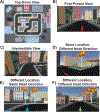Rethinking retrosplenial cortex: Perspectives and predictions
- PMID: 36460006
- PMCID: PMC11709228
- DOI: 10.1016/j.neuron.2022.11.006
Rethinking retrosplenial cortex: Perspectives and predictions
Abstract
The last decade has produced exciting new ideas about retrosplenial cortex (RSC) and its role in integrating diverse inputs. Here, we review the diversity in forms of spatial and directional tuning of RSC activity, temporal organization of RSC activity, and features of RSC interconnectivity with other brain structures. We find that RSC anatomy and dynamics are more consistent with roles in multiple sensorimotor and cognitive processes than with any isolated function. However, two more generalized categories of function may best characterize roles for RSC in complex cognitive processes: (1) shifting and relating perspectives for spatial cognition and (2) prediction and error correction for current sensory states with internal representations of the environment. Both functions likely take advantage of RSC's capacity to encode conjunctions among sensory, motor, and spatial mapping information streams. Together, these functions provide the scaffold for intelligent actions, such as navigation, perspective taking, interaction with others, and error detection.
Keywords: allocentric; egocentric; episodic memory; navigation; network oscillations; orientation; perspective taking; predictive coding; spatial transformation; temporal sequence.
Copyright © 2022 Elsevier Inc. All rights reserved.
Conflict of interest statement
Declaration of interests The authors declare no competing interests.
Figures








References
-
- van Groen T. & Michael Wyss J. Connections of the retrosplenial granular a cortex in the rat. J. Comp. Neurol 300, 593–606 (1990). - PubMed
-
- Van Groen T. & Wyss JM Connections of the retrosplenial granular b cortex in the rat. J. Comp. Neurol 463, 249–263 (2003). - PubMed
-
- Wyass JM & Van Groen T. Connections between the retrosplenial cortex and the hippocampal formation in the rat: A review. Hippocampus 2, 1–11 (1992). - PubMed

